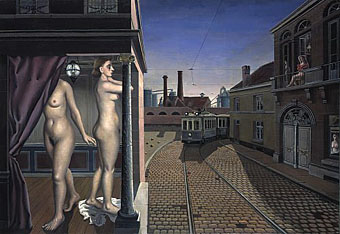
La Rue du Tramway (1938) by Paul Delvaux.
Taxandria (1994) is a feature-length fantasy film by Belgian animator Raoul Servais that’s received little attention outside his native country, possibly because it failed in the marketplace and has been deemed too weird or uncommercial to export. You only have to compare the export version of Harry Kümel’s Malpertuis with his original cut to see how inventive Belgian films are treated by US distributors.
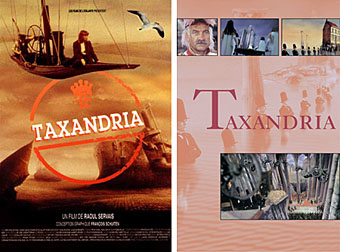
Servais had previously made an acclaimed animated short, Harpya, using a combination of live actors and painted backgrounds. Taxandria elaborates on this process (called Servaisgraphy by its inventor) using settings designed by one of my favourite comic artists François Schuiten, creator (with Benoît Peeters) of Les Cités Obscures. Taxandria intrigues for a third reason, the inspiration of Surrealist master Paul Delvaux whose paintings served as the origin of the project. And it also contains a remarkable detail in the screenplay credit for Alain Robbe-Grillet, a man better known for making Last Year at Marienbad with Alain Resnais, and the kind of fierce intellectual one imagines would usually run a mile from this kind of extravagant whimsy.
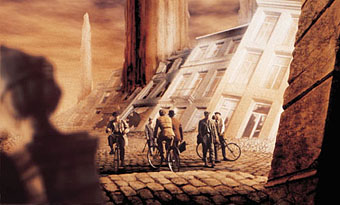
From the Servais website biography:
After Harpya, another project was haunting his imagination. We know he worked with Magritte and we know how he admires surrealism in general. But the painter who for a long time had fascinated him most (and who lived next door in St. Idesbald) was Paul Delvaux. His oneiric ghost-towns populated by pale naked women, absent-minded scholars and vacant men, all dressed up, the abandoned railway-stations and trains without destination—all attracted Servais’ attention. He sets off to try out some shots inspired by Delvaux’ paintings in “Servaisgraphy” and is rather pleased with the result. Servais talks it over with the eighty-year-old painter, who accepts the idea to see his universe become part of an animation film. Servais writes a first draft of the plot, which is definitely meant to become a full-length feature film rather than a short film. Supported by a writing and pre-production grant of the Flemish Community, he goes in search of a producer, because the project turns out to be long and complex—and therefore expensive. The time Servais made a Goldframe on his own account has long gone. Since 1983, a heavy story-board tells the story of a land called Taxandria (the name actually exists: it is the name of a province of Gaulish Belgium). Taxandria is, of course, an imaginary country, much like The Nebelux in Operation X-70, one of these anti-utopias that are timeless in literature.
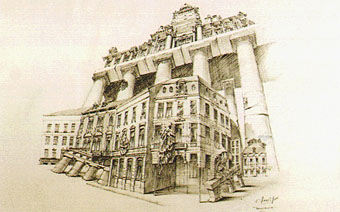
A lighthouse guardian leads a young prince towards an imaginary world, Taxandria, where the boy learns about the power of love and the value of liberty.
A totalitarian regime has forbidden time: time watches have been confiscated, photo cameras are illegal as they freeze a point in time. A typical Servais theme: a power is oppressed by a constraint that denies what is best in the individual, and therefore has to be twisted in various ways, to establish an entirely artificial world, that has rules that may question some of the rules of our world at this side of the mirror.
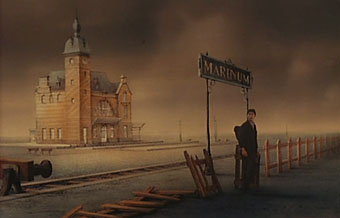
Servais’ producer wasn’t convinced that Delvaux’s paintings could support a whole film so Schuiten was brought in to develop these and reconfigure them to suit the screen, the result being a curious hybrid of both artists’ styles with Delvaux’s vertically flat tableaux mutating into Schuiten’s lofty and fantastic architecture. The drift away from the painted world evidently left Servais unsatisfied since his next film, Nocturnal Butterflies, is another short that more fully realises Delvaux’s twilight realm of large-eyed, bare-breasted women in antiquated settings.
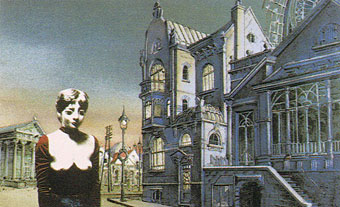
Taxandria seems to be unavailable on DVD but Servais’ short films—including Harpya and Nocturnal Butterflies—have been collected on Raoul Servais—The Complete Collection of Short Films, a Region 2 release from Boomerang Pictures (Belgium) / Doriane Films (France).
More screenshots from Taxandria, and information about the rest of his films, at Raoul Servais’ website.
Previously on { feuilleton }
• The Brothers Quay on DVD
• Barta’s Golem

John
great piece.
love the way those vertical lines get unhinged. sometimes dramtically, sometimes a leaning telegraph pole or just a picket in a fence is enough
Jeez, how do we get any (paying) work done, we’re so busy poring over other stuff?
Eddie
Thanks Eddie. I love the way Schuiten plays with architecture, it’s a shame (and surprising) that he hasn’t done more film design.
Schuiten AND Delvaux ! That’s priceless.
I love both so I should really seek this movie…
I realize this is an old topic, but for those interested there is an official Greek DVD release of Taxandria. I got mine from eBay today. It’s a no-frills release with the picture cropped for the TV-format. It’s not Criterion, but at least available.
Taxandria is up in 8 parts in HD on You Tube! beautiful film, my fave part is when Aimee goes to the pier (Marinum) near the end (photo is above in the original post).